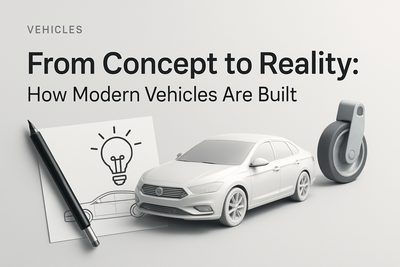
Introduction
As we move further into the 21st century, automotive technology continues to evolve at an incredible pace. One of the most significant areas of innovation is vehicle safety. Automakers and regulators alike are pushing for smarter, more intuitive systems that not only protect occupants during a crash but also prevent accidents from happening in the first place. By 2025, many safety features that were once considered optional or available only in luxury vehicles will become standard across most new models. These advancements aim to make roads safer, reduce fatalities, and bring us closer to fully autonomous driving. In this post, we'll explore seven game-changing safety features that every new car is expected to have by 2025.
1. Automatic Emergency Braking (AEB)
Automatic Emergency Braking (AEB) is already becoming common in many new vehicles, but by 2025, it will be a standard feature. AEB systems use sensors, cameras, or radar to detect an imminent collision with another vehicle or object and automatically apply the brakes if the driver doesn’t react in time. This technology has proven to significantly reduce rear-end collisions and is being heavily promoted by safety organizations and government regulations worldwide.
Why It Matters:
- Can prevent or mitigate collisions.
- Reduces reaction time dependence on the driver.
- Often works in tandem with other safety systems like Forward Collision Warning (FCW).
2. Lane Keeping Assist (LKA) and Lane Departure Warning (LDW)
Drifting out of lanes due to distraction or drowsiness is a major cause of highway accidents. Lane Departure Warning (LDW) alerts drivers when they unintentionally stray from their lane, while Lane Keeping Assist (LKA) goes a step further by gently steering the car back to the center of the lane.
Key Benefits:
- Helps prevent sideswipe crashes and run-off-road incidents.
- Reduces fatigue on long drives.
- Enhances driver awareness and control.
3. Blind Spot Detection Systems
Changing lanes without properly checking blind spots can lead to dangerous collisions. Blind Spot Detection uses radar or cameras to monitor areas the driver can't see and typically provides visual or auditory alerts when a vehicle enters those zones. Some advanced systems even provide gentle steering or braking interventions to avoid a collision.
What to Expect:
- Standard inclusion in entry-level models.
- Integration with mirrors or dashboard alerts.
- Combined with Rear Cross-Traffic Alert for parking lot safety.
4. Driver Monitoring Systems (DMS)
As cars become more autonomous, monitoring the driver's attention remains crucial. Driver Monitoring Systems use infrared cameras and facial recognition technology to ensure the driver is alert and focused. If signs of drowsiness or distraction are detected, the system issues warnings and, in some cases, takes corrective actions.
Features May Include:
- Eye-tracking to detect sleepiness or distraction.
- Seat vibration or audio alarms as alerts.
- Integration with ADAS for adaptive assistance.
5. Pedestrian and Cyclist Detection
Urban environments are busy, and protecting vulnerable road users like pedestrians and cyclists is a growing priority. Advanced systems now combine AI and real-time imagery to identify people on foot or on bikes—even in low visibility conditions—and can automatically apply brakes if a collision is imminent.
Safety Improvements:
- Reduces urban accident rates.
- Improves nighttime and bad-weather detection.
- Works seamlessly with Automatic Emergency Braking (AEB).
6. 360-Degree Camera Systems
Parking in tight spaces or navigating congested areas is significantly easier and safer with a 360-degree camera system. These systems stitch together views from multiple cameras around the vehicle to create a bird’s-eye view, showing all surroundings in real time on the infotainment screen.
Advantages:
- Eliminates blind spots during parking.
- Enhances safety for pedestrians and small objects.
- Reduces minor scrapes and fender benders.
7. Adaptive Headlights and High-Beam Assist
Visibility is a critical factor in nighttime driving safety. Adaptive headlights adjust their direction based on your steering to illuminate curves better, while high-beam assist turns your high beams on or off automatically depending on oncoming traffic. By 2025, these features are projected to be standard in most new cars.
Benefits:
- Improved visibility around curves and hills.
- Minimizes glare for other drivers.
- Safer night driving conditions.
Conclusion
The future of driving is not just about speed or style—it's about safety. The integration of advanced driver-assistance systems is transforming new vehicles into smarter, more protective machines. By 2025, features like Automatic Emergency Braking, Lane Keeping Assist, and Pedestrian Detection will no longer be reserved for top-tier models; they'll be standard safeguards for everyone on the road. As automakers continue to innovate and safety standards rise globally, car buyers can look forward to vehicles that are not only more intelligent but significantly safer. Whether you're a seasoned driver or a new one, these advancements ensure peace of mind each time you get behind the wheel.
Stay informed and drive safe—the future is closer than you think.







